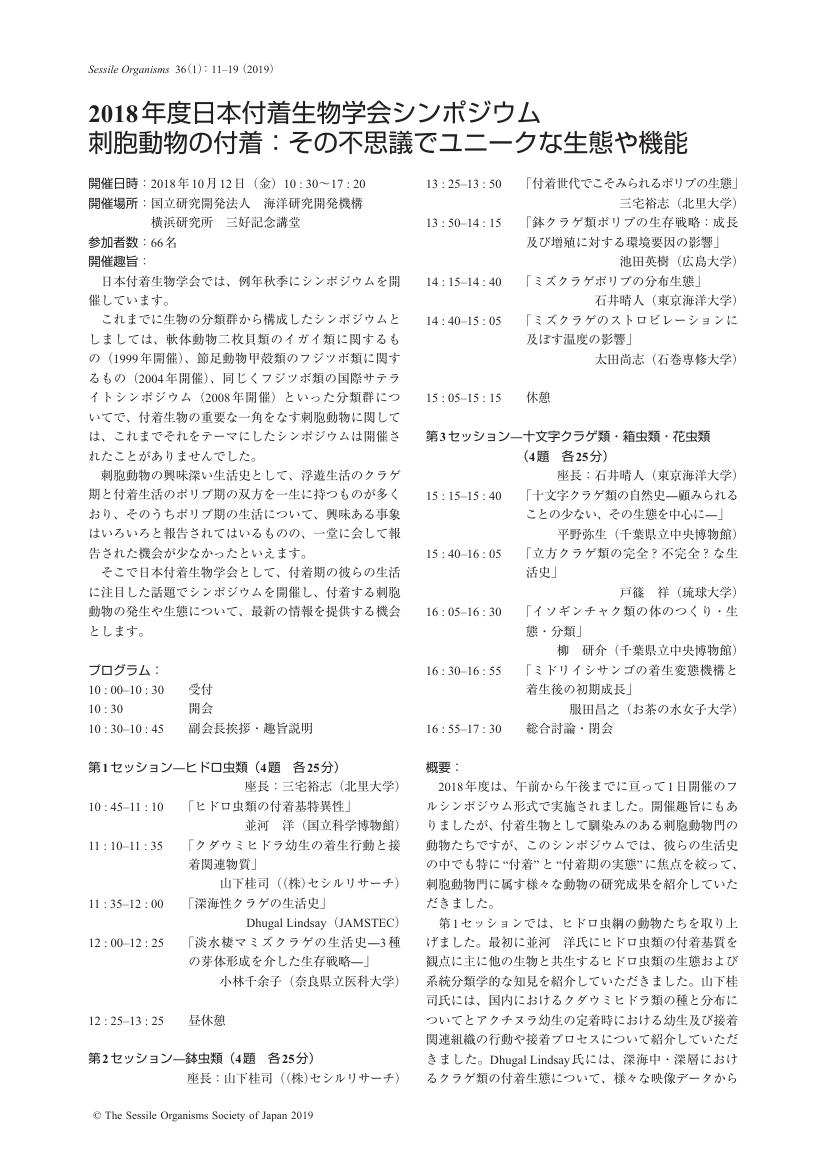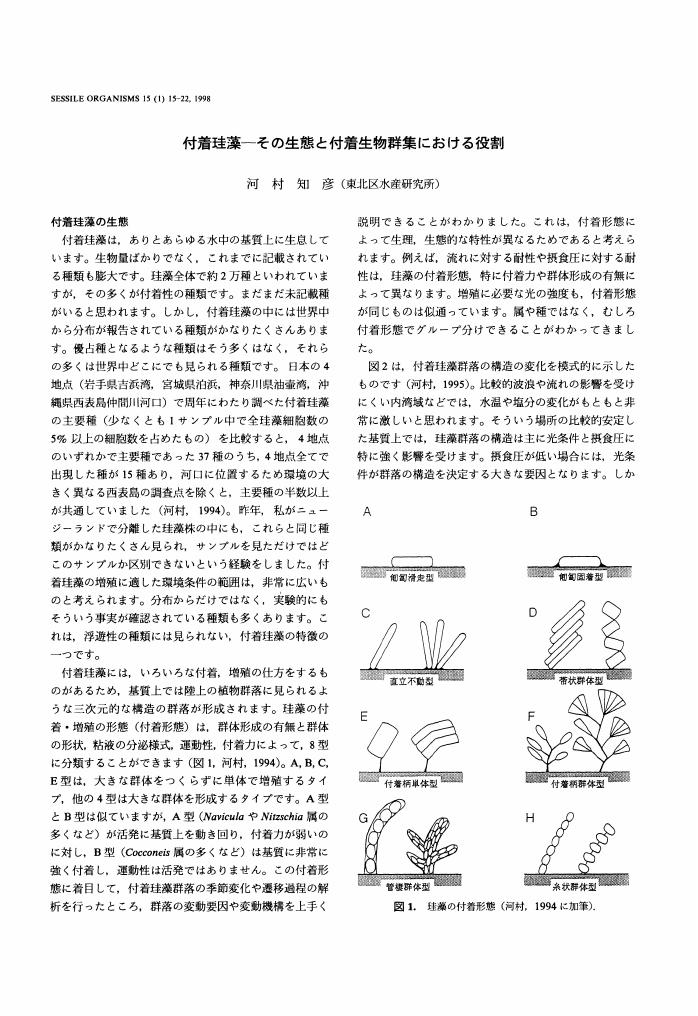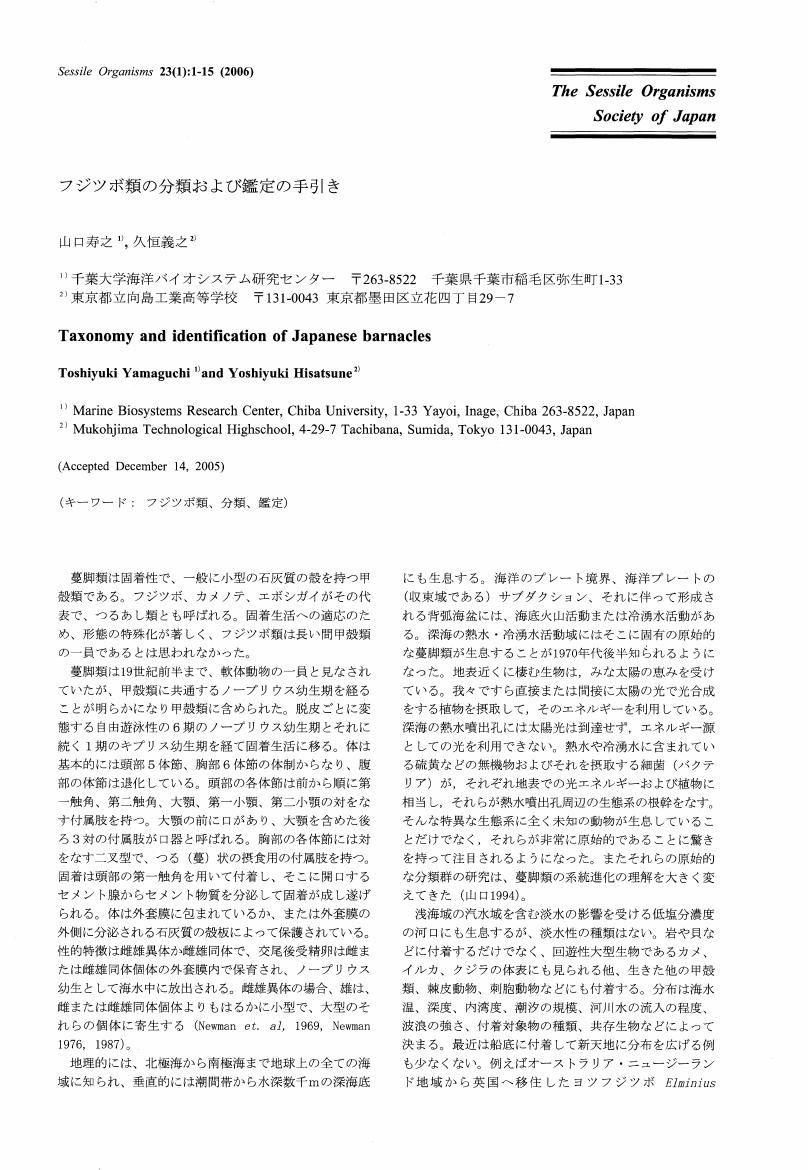6 0 0 0 OA ムラサキイガイかチレニアイガイか-動物和名選定のケーススタディ
- 著者
- 西川 輝昭
- 出版者
- THE SESSILE ORGANISMS SOCIETY OF JAPAN
- 雑誌
- Sessile Organisms (ISSN:13424181)
- 巻号頁・発行日
- vol.13, no.2, pp.1-6, 1997-02-15 (Released:2009-10-09)
- 参考文献数
- 46
- 被引用文献数
- 1
- 出版者
- 日本付着生物学会
- 雑誌
- Sessile Organisms (ISSN:13424181)
- 巻号頁・発行日
- vol.36, no.1, pp.11-19, 2019-01-01 (Released:2019-06-11)
2 0 0 0 OA 付着珪藻-その生態と付着生物群集における役割
- 著者
- 河村 知彦
- 出版者
- THE SESSILE ORGANISMS SOCIETY OF JAPAN
- 雑誌
- Sessile Organisms (ISSN:13424181)
- 巻号頁・発行日
- vol.15, no.1, pp.15-22, 1998-08-30 (Released:2009-10-09)
- 参考文献数
- 20
- 被引用文献数
- 3 3
2 0 0 0 OA 付着生物群集としての端脚類
- 著者
- 樋渡 武彦
- 出版者
- 日本付着生物学会
- 雑誌
- Sessile Organisms (ISSN:13424181)
- 巻号頁・発行日
- vol.14, no.2, pp.25-32, 1998-02-15 (Released:2009-10-09)
- 参考文献数
- 26
- 被引用文献数
- 1 1 1
- 著者
- Angem Librando-Descallar Zhengyi Ling Takuma Haga Tatsufumi Okino
- 出版者
- THE SESSILE ORGANISMS SOCIETY OF JAPAN
- 雑誌
- Sessile Organisms (ISSN:13424181)
- 巻号頁・発行日
- vol.40, no.1, pp.1-12, 2023-03-14 (Released:2023-03-14)
- 参考文献数
- 48
Shipworms of the family Teredinidae were collected from driftwood along the coastal areas of Hokkaido between October 2020 and November 2021. Identification of species recorded a total of five species pervaded wooden debris: Teredo navalis Linnaeus, 1758, Lyrodus pedicellatus (Quatrefages, 1849), Bankia setacea (Tryon, 1863), Bankia bipennata (Turton, 1819), and Bankia carinata (Gray, 1827), the latter two were warm-water elements and considered a new record of species discovered from the temperate zone of Hokkaido waters. This suggests the possibility that ocean currents and suitable environmental conditions caused the settlement of these teredinids in driftwood along the vast coastal stretches of Hokkaido. Also, B. bipennata and B. carinata have been most likely distributed along the Sea of Japan and brought accidentally by typhoons from the Kuroshio region and Tsushima and Tsugaru currents to Hokkaido, respectively. Moreover, biogeographic patterns within Teredinidae from other coastal areas in the country and elsewhere were examined from the available literature.
1 0 0 0 OA カタユウレイボヤにおける固着生活とセルロースの関係
- 著者
- 笹倉 靖徳
- 出版者
- THE SESSILE ORGANISMS SOCIETY OF JAPAN
- 雑誌
- Sessile Organisms (ISSN:13424181)
- 巻号頁・発行日
- vol.24, no.2, pp.127-131, 2007-08-31 (Released:2009-10-09)
- 参考文献数
- 40
- 被引用文献数
- 1 1
Ascidians have the most simple chordate body plan. Ascidians share one curious characteristic in that they produce cellulose. Cellulose is a major component of tunic that surrounds the whole body of ascidians. Recent genome project and phylogenetic analyses of the ascidian, Ciona intestinalis, suggest that (1) ascidians have a gene encoding cellulose synthase, and (2) ascidian may have acquired cellulose synthase through lateral transfer from bacteria. Developmental genetics of Ciona intestinalis with the transposon Minos has generated one mutant for cellulose synthase. This mutant shows abnormal metamorphosis and settlement, suggesting that cellulose is required in the sessile life of this ascidian.
1 0 0 0 OA フジツボ類の分類および鑑定の手引き
- 著者
- 山口 寿之 久恒 義之
- 出版者
- THE SESSILE ORGANISMS SOCIETY OF JAPAN
- 雑誌
- Sessile Organisms (ISSN:13424181)
- 巻号頁・発行日
- vol.23, no.1, pp.1-15, 2006-02-20 (Released:2009-10-09)
- 参考文献数
- 36
- 被引用文献数
- 5 4
1 0 0 0 OA 石灰藻のピリヒバより抽出された水溶性物質によるアカウニ幼生の変態誘起
- 著者
- 高 炯範 北村 等 平山 和次
- 出版者
- THE SESSILE ORGANISMS SOCIETY OF JAPAN
- 雑誌
- Sessile Organisms (ISSN:13424181)
- 巻号頁・発行日
- vol.13, no.1, pp.1-5, 1996-08-30 (Released:2009-10-09)
- 参考文献数
- 11
- 被引用文献数
- 1 1
Water-soluble substance extracted from the coralline alga, Corallina pilulifera have the effect of induction of larval metamorphosis on the sea urchins, Pseudocentrotus depressus and Anthocidaris crassispina.The chemical cue for larval metamorphosis of P. depressus in the solution was heat stable and remained active even if its treated with organic solvent. Concentration of the potassium in an active fraction was not so high to induce the larval metamorphosis. The cue could be other inorganic ions or organic substances.
1 0 0 0 OA サンゴモ類の生態
- 著者
- 藤田 大介
- 出版者
- THE SESSILE ORGANISMS SOCIETY OF JAPAN
- 雑誌
- Sessile Organisms (ISSN:13424181)
- 巻号頁・発行日
- vol.16, no.1, pp.17-25, 1999-08-30 (Released:2009-10-09)
- 参考文献数
- 26
- 被引用文献数
- 1 1
1 0 0 0 OA タテジマフジツボ幼生の飼育法およびキプリス幼生を用いた循環流水式の付着試験法
- 著者
- 北村 等
- 出版者
- 日本付着生物学会
- 雑誌
- Sessile Organisms (ISSN:13424181)
- 巻号頁・発行日
- vol.15, no.2, pp.15-21, 1999-02-15 (Released:2009-10-09)
- 参考文献数
- 15
- 被引用文献数
- 4 4
1 0 0 0 岩手県越喜来湾における褐藻ヒジキの多回収穫型養殖
- 著者
- 難波 信由 佐藤 新 小河 久朗 加戸 隆介
- 出版者
- 日本付着生物学会
- 雑誌
- Sessile organisms (ISSN:13424181)
- 巻号頁・発行日
- vol.25, no.1, pp.17-23, 2008-02-29
- 被引用文献数
- 2
Both intact thalli of <i>Sargassum fusiforme</i> and those without holdfasts were aquacultured in Okirai Bay, Northeast Japan, to establish them as a multi-harvestable aquaculture resource. Elongated main branches (edible part) of the intact thalli were harvested twice (August 2005 and June 2006) during 1.5 years of aquaculture (November 2004-June 2006). However, two fouling organisms, <i>Laminaria japonica</i> and <i>Mytilus galloprovincialis</i>, also occurred on the aquaculture rope. As a fouling countermeasure, <i>S. fusiforme</i> thalli without holdfasts were aquacultured for 6 months (February-August 2005) with freshwater treatment (biweekly 2-min exposures). Their stipes regenerated holdfasts, and the attached holdfasts elongated around the aquaculture rope; moreover, the new holdfasts gave rise to a number of stipes, which became the bases of new main branches. The elongated main branches were harvested after 4 months of aquaculture. Thalli without holdfasts collected from the rope were aquacultured again for ca. 1 year (October 2005-August 2006) with the same freshwater treatment. After 8 months, elongated main branches were harvested from these thalli with their new regenerated holdfasts. The freshwater treatment was effective to remove <i>L. japonica</i>, but it had no effect on fouling by <i>M. galloprovincialis</i>. Therefore, the two successive harvests were conducted before the mass occurrence of <i>M. galloprovincialis</i> in the summer.
1 0 0 0 OA 研究情報
- 出版者
- 日本付着生物学会
- 雑誌
- Sessile Organisms (ISSN:13424181)
- 巻号頁・発行日
- vol.23, no.1, pp.25-37, 2006-02-20 (Released:2009-10-09)
1 0 0 0 OA 付着生物対策と電気事業
- 著者
- 清野 通康
- 出版者
- 日本付着生物学会
- 雑誌
- Sessile Organisms (ISSN:13424181)
- 巻号頁・発行日
- vol.20, no.1, pp.11-13, 2003-02-28 (Released:2009-10-09)
- 被引用文献数
- 2 1
Biofouling control of cooling water systems has been one of the severe problems for power plant operation. A lot of works have been carried out and many physical/chemical control methods are available. However, practical measures satisfied following criteria have not been developed: (1)reliable control for a long enough term, (2)broad availability, (3)low environment impacts, (4)simply operating, and (5)reasonable cost. Power plants have been coping with biofouling, using a combination of some measures applicable. Possible research targets of practical anti-biofouling are discussed from a user's view.
1 0 0 0 OA 発電所の取水影響と付着生物
- 著者
- 原 猛也 山田 裕 青山 善一 杉島 英樹 藤澤 俊郎
- 出版者
- 日本付着生物学会
- 雑誌
- Sessile Organisms (ISSN:13424181)
- 巻号頁・発行日
- vol.22, no.2, pp.35-45, 2005-08-28 (Released:2009-10-09)
- 参考文献数
- 21
- 被引用文献数
- 1
全国の沿岸を北方、中部、南部の3海域に分け、それぞれの海域ごとに1カ所の代表発電所を選定し、取水口、放水口において採集した標本を比較するなどの方法により発電所の冷却水路に取り込まれた動・植物プランクトン、魚卵、稚仔魚に対する取放水系通過の影響を調査した。その結果、1. 植物プランクトンの死亡率は、塩素注入時に大きく約30%であった。2. 動物プランクトンの死亡率は、わずか数%であった。3. 動・植物プランクトンの減耗量は、水路長が長ければ大きく、水温が高ければ大きいが、海域、発電所の構造などによって減耗量の程度は異なる。4. この減耗の主要因は付着生物による捕食と考えられた。この影響は、水路内で受ける他の要因 (機械的、化学的、昇温) による影響に比べ大きい。5. 水路通過時に何らかの影響を受けた動・植物プランクトンは、放水口から放流された後は、速やかに周辺の群と混合して、活性度、生残率、細胞密度、個体数密度は回復した。6. 動・植物プランクトンへの水路通過影響が検出される範囲は、放水口近傍の温排水内に限られた。7. 魚卵、稚仔魚が受ける水路通過による影響は、従来、動・植物プランクトンより大きく、100%死亡するものとして扱われてきたが、放水口から放出されたときの生存率は少なくても30%以上であると推定された。







